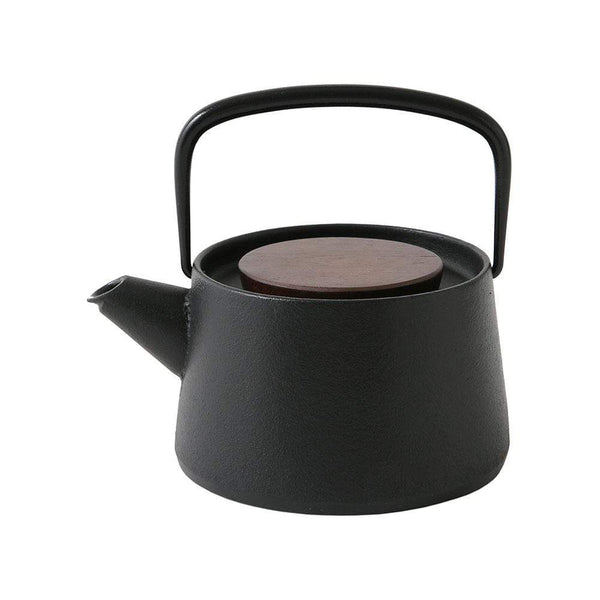The products we used:
The Difference: Kettles vs Teapots


The main difference between kettles and teapots is the inside of the pot. Kettles are meant for simply boiling water. Teapots are designed to have tea steeped in them, and thus have an enamel inner coating. Kettles, without that coating, will rust quickly if water is left inside them for an extended period of time. Steeping tea and serving it from a teapot doesn't post the same rust risk.
In addition to the enamel inner coating, teapots come with tea strainers for putting tea bags or loose tea leaves in. Iron is also very good at holding in heat, so the tea you make in the teapot will stay hot for longer than tea made in a glass or ceramic teapot.
Preparing Your Kettle

Because water will make direct contact with the iron inside the pot, it's important to prepare it for use. Kettle users since time immemorial have passed down a technique for preparing and protecting iron kettles from rust: mineral deposits.
If you live in a home with hard water, you know that the mineral deposits that hard water produces can really gunk up your plumbing and kitchen appliances. My parents filter their water through water softener to prevent those mineral deposits from building up at the bottom of the water filters and coffee pots.
But, in the case of iron kettles, those mineral deposits (called yuaka in Japanese) are your friend! Mineral deposits in an iron kettle create a natural coating to protect the iron from rusting. Well maintained kettles can turn nearly completely white due to that natural mineral coating!
Thus, before you use your kettle for the first time, it is recommended to clean out the kettle and create the beginnings of your mineral deposit coating.
- Fill the kettle 70% of the way with hard water. It's important that the water you use contain the minerals necessary to create the coating.
- Leave the lid off.
- Boil at medium heat (medium-low if you use an IH stove) for 20 minutes.
- Put the lid on and pour the water out into the sink. You'll notice that the water is a bit discolored by iron. We don't want that.
- Leave the kettle the cool and dry out. The latent heat will dry out the kettle.
- Repeat steps 1-5 three times, or until the water no longer discolors.
After this preparation, you should notice the beginnings of a mineral deposit coating: small blotches of white on the bottom of the inside of the kettle.
Please note that if the water you use isn't hard, you aren't going to get the coating and the kettle is likely to rust.
Congratulations, you now are ready to start using your kettle!
Preparing Your Teapot

As I said before, because of the inner enamel coating, no special preparation is necessary. Just clean it out with water before using it.
Using Your Kettle or Teapot

If you haven't used iron kitchen appliances before, then you'll want to keep a few things in mind:
- Iron is hot. Use mittens or a sarashi when handling your kettle or teapot.
- When using your kettle at a table, we also recommend placing it on a sarashi or pot holder to avoid heat damage, scratching, or denting. The teapot from Ikenaga comes with an iron plate for placing the teapot on your table.
- Don't cool the teapot down too quickly or else you risk damaging the enamel coating.
Caring For Your Kettle or Teapot


As you can imagine, caring for a kettle takes a bit more thought than a teapot. The main thing to remember is not to allow water to sit in or on your kettle for an extended period. After using it, immediately pour out any remaining water and let the heat in the kettle dry out the residual water with the lid off. If you are especially worried about rust, you can also wipe the inside with a dry cloth. The rust risk depends on the hardness or softness of the water you use, so it's up to you to decide whether to leave the hot water to dry or to wipe it with a cloth.
If any water gets on the outside of your kettle or teapot, we recommend wiping it off with a towel to prevent rust.
Store your kettle or teapot in a dry place.







